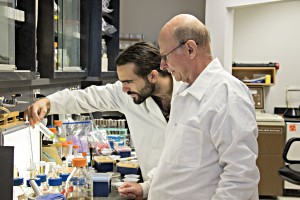UMCES-IMET DOCTORAL CANDIDATE JAN VICENTE EARNS NSF POSTDOCTORAL FELLOWSHIP

For six years, former NOAA Living Marine Resources Cooperative Science Center (LMRCSC) and Nancy Foster Scholar, Jan Vicente has been studying sponge-to-sponge symbioses, or when two species cohabitate for mutual benefits, in the Caribbean and their resilience to climate change.
Now, Vicente will continue studying sponges of the Indo-Pacific after he finishes his doctoral degree this fall through a National Science Foundation Postdoctoral Research Fellowship in Biology. Vicente will be hosted by the Hawai’i Institute of Marine Biology at the University of Hawai’i at Mānoa, and will be working with Robert J. Toonen, Ph.D. Toonen is a renowned population biologist and is one of the lead scientists of Autonomous Reef Monitoring Structures (ARMS), monitoring devices used to assess spatial patterns and temporal trends in the diversity of cryptic invertebrates that settle on reefs.
As part of this fellowship, Vicente will explore a new sequencing approach to provide reduced genomes of sponge species that settle on ARMS in the Coral Triangle. His project is titled “Is the Coral Triangle a hot spot of sponge biodiversity?” and uses a newly developed molecular tool called ezRAD, which allows for the efficient sequencing of genomes.
Vicente is currently a Ph.D. candidate in the Marine Estuarine and Environmental Sciences Program at the Institute of Marine and Environmental Technology (IMET), which is part of the University of Maryland Center for Environmental Science. He will defend his doctoral dissertation in September 2016, and start the two-year fellowship the following month. Vicente has been studying the nature of sponge-to-sponge interactions for three different sponge associations and their resilience under different climate change scenarios.
Vicente started his doctoral degree in 2010 and was funded by the LMRCSC until 2012.
“The reason I’m here in Maryland and at IMET is because of the LMRCSC. When I was accepted, I called Russell Hill, who connected me with Rose Jagus, the LMRCSC project director at IMET,” Vicente said. “The LMRCSC was able to fund my education for two years. Being mentored by an excellent microbiologist and funded by the LMRCSC was what made me come to Maryland.”
Hill became Vicente’s advisor, and it was with his encouragement that Vicente applied for and earned the Nancy Foster Scholarship in 2012, which has covered his educational costs since.

“Russell is incredible at encouraging students to be independent. He pushed me to think of my own ideas and come up with my own project,” Vicente said. “He encouraged me to apply the Nancy Foster scholarship — and one opportunity led to the next.”
While part of the Nancy Foster program, Vicente interned at the Hawaiian Islands Humpback Whale National Marine Sanctuary in the summer of 2014. One of Vicente’s fellow Foster scholars connected him to his future postdoc advisor, Toonen, who would later agree to be the faculty sponsor for Vicente’s NSF postdoctoral application.
“When I saw the call for the postdoc position, I immediately thought back to the internship in Hawaii and emailed Dr. Toonen,” Vicente said. “The research I will do in my postdoc will help me answer a lot of questions that remained unanswered during my doctoral research.”
Vicente will first collect samples from the Coral Triangle to learn more about the existing population. He’ll apply his understanding of the diversity of sponge species to determine which species he will request from the biological collections at the National Museum of Natural History in Washington D.C and the Florida Museum of Natural History. Then, he will conduct a reduced genomic analysis of the sponges collected from the Coral Triangle and the museum collections. Vicente hopes that this comparison will inform a larger conversation on where the species originated, how they are evolving, and how they are moving or dispersing throughout the Coral Triangle.
Vicente received his B.S. in Biology from the University of Puerto Rico Rio Piedras in 2007, where he gained experience in natural product chemistry and chemotaxonomy of sponges. Inspired by the microbial world of sponges, he went on to complete a M.S. in Marine Science with a minor in Marine Policy from the University of North Carolina Wilmington in 2010. He then gained valuable experience as a sponge course participant of the 2010 NSF-AToL: Taxonomy, Systematics, and Ecology of Caribbean Sponge.
Photo Caption: Top, right – Jan Vicente, doctoral candidate at UMCES-IMET; Bottom, left – Jan Vicente and his advisor Russell Hill in the lab.
Photo Credit: University of Maryland Center for Environmental Science/Cheryl Nemazie

